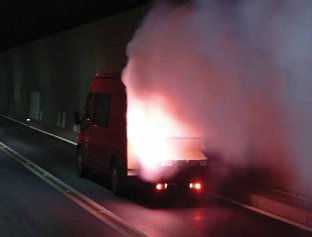Norwegian fire incidents
24 May 2018Tunnels and Tunnelling got in touch with Arild Søvik, CEO of Søvik Consulting following his presentation at Stuva 2017. At the event Søvik presented a study of recent Norwegian tunnel fire incidents and the response of authorities
IN 2011 A FIRE in the Oslofjord tunnel in Norway resulted in a number of injuries and prompted the Accident nvestigation Board of Norway (AIBN) to undertake an investigation.
AIBN initially noted that self-rescue was inhibited by a failure of “interaction between information to road-users, safety equipment, ventilation solution/smoke control, firefighting and safe road-user evacuation”.
The response was to request that the Norwegian Public Roads Administration, along with other authorities, review and update emergency response plans for long, single-lane tunnels. All parties agreed that the move was necessary and so work began on the Oslofjord tunnel as a specific case.
ACTION AT OSLOFJORD
The general philosophy is that time cannot be wasted during a tunnel fire. It cannot be allowed to build unperturbed, and people cannot just sit still taking no action to save themselves. Consequently, the tunnel systems must detect the fire early, close the tunnel, alert emergency services, engage early smoke control. Additionally, of utmost importance is the start of the evacuation of road users. In other words, reaction time.
To facilitate this, LED lights were installed to guide people through a smoke-filled tunnel to 25 new refuge rooms [also called ‘evacuation chambers’ in some of the documentation, but have no escape route to the surface – Ed].
Then, in 2017, fire once again struck Oslofjord, and once again it was caused by an engine fault. The subsequent investigation found that fire extinguishing systems and the new evacuation measures worked as intended and were effective in reducing harm to other road users.
Søvik says that although the EU tunnel safety directive 2004/54/EC prohibits these refuge rooms, the lessons learned from the fire should open up a discussion about the design of effective fire counter measures for tunnels with unusual characteristics (e.g., a steep gradient, which is of course, less unusual in Norway than elsewhere). The Norwegian Public Roads Administration has initiated a survey to gather further information.
SKATESTRAUM TANKER FIRE
In 2015, in a subsea tunnel in Norway, a tanker carrying 16,500 litres of petrol burst into flames. This incident in the Skatestraum tunnel led to extensive damage. In this case the focus was on how appropriate the infrastructure is totransport dangerous goods.
Regarding Skatestraum, the AIBN said, “The fire escalated so quickly and sparked so much energy that it was a very short window of time available for evacuation. AIBN therefore recommends the introduction of restrictions on the transport of dangerous goods based on a risk assessment of each individual tunnel.”
The steep gradient of the tunnel helped the fire spread over a far greater section of the tunnel than expected; the petrol simply ran along the road surface, completely overwhelming drainage systems that were not designed to handle the sheer volume of petrol that leaked from the tanker.
In addition to the earlier lessons, Skatestraum highlighted the importance of adequate drainage, which was made necessary by this combination of factors.
SUMMARY OF TUNNEL FIRES
AND SAFETY STRATEGY
Søvik emphasises that heavy vehicles are over-represented in the Norwegian fire statistics, and particularly so for highgradient tunnels. Technical faults in heavy vehicles were found to be the cause of fires more than twice as often as light vehicles. Additionally, 40 per cent of all tunnel fires in the country occur in tunnels steeper than 5 per cent. Gradient restrictions are becoming tighter, necessitating design changes. Søvik adds, “Fires in a building will give those in the building a reasonable opportunity to escape to a safe zone. It is a short distance in most cases. In a tunnel, you have to escape from your location to the portal outside of the tunnel. If there is an escape tunnel, this can be used. For long one-tube tunnels the safe zone may be several kilometres away which often undermines the principle of self-rescue.
“The AIBN has in its investigations questioned whether the road authorities have adequately facilitated the tunnels so that the road users have a real chance to evacuate on their own in a tunnel fire (self-rescue).
“The principle of self-rescue applies to all tunnels, but it poses a challenge in long single tube tunnels and especially tunnels with a high gradient. Serious incidents that challenge the self-rescue principle are primarily incidents with high fire impact and a rapid smoke development, mainly incidents involving heavier vehicles. Fire in vehicles in shorter road tunnels challenges the principle to a lesser extent than fire in vehicles in road tunnels with longer distances for evacuation. A high gradient, which affects the ability to control the smoke, can make evacuation difficult and therefore affects the possibility of self-rescue.
Technical problems due to weakness in a heavier vehicle and or lack of knowledge and experience with the driver, are major causes for such incidents. “In its new strategy, NPRA aims to reduce the probability of an incident occurring, be well prepared for different scenarios, as well as utilise time well by detecting fire early, closing the tunnel, alerting emergency services, getting early smoking control and launch notification to the road users and start evacuation. Furthermore, safety equipment shall make it easier to evacuate in a smoke-filled tunnel, if road users are caught in the smoke.”
The Norwegian Public Roads Administration and the Directorate for Civil Protection held seminars held stakeholder seminars focusing on preparedness and cooperation. Input has been taken from a range of interested groups, including emergency services, rescue teams, researchers, advisers, producers and suppliers.
“Knowledge of interaction between people, technology and organisations is crucial for the tunnel safety. Optimising the inter- action between people, technology and organization is important for a well-functioning and effective self-rescue. This interaction can be decisive when it comes to damage and the overall consequences of an incident,” concludes Søvik.

